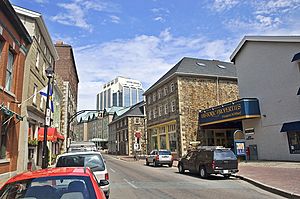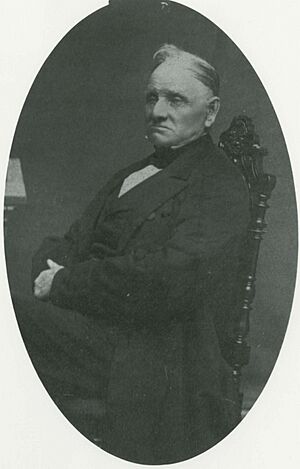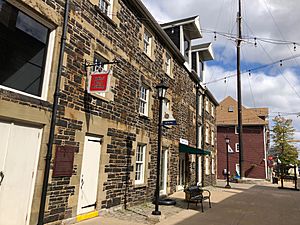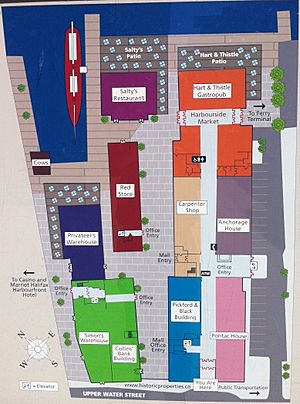Historic Properties facts for kids
The Historic Properties are a group of old warehouses located on the Halifax Boardwalk in Halifax, Nova Scotia. They are sometimes called Privateers' Wharf. These buildings started being built during the Napoleonic Wars, a long time ago, by clever Nova Scotian business people like Enos Collins. He was a privateer, which meant he had a special license to use his ships to capture enemy merchant ships during wartime. His ships were so brave they even managed to get supplies to the British commander Duke of Wellington when Napoleon had blocked many sea routes!
These properties were super important for making Halifax a rich and busy place in Canada's early days. They helped with trade and business, but they were also used for privateering. During the War of 1812, two very famous Nova Scotian privateer ships were the Liverpool Packet and the Sir John Sherbrooke. Later, a folk singer named Stan Rogers made Privateers' Wharf even more famous in his songs "Barrett's Privateers" and "Bluenose". One of the buildings, Pontac House, is named after a famous old restaurant called the Great Pontack, which was in Halifax when the city was first founded in 1749.
Contents
A Look Back: Privateers and the War of 1812
The Historic Properties remind us of an exciting time, especially around the War of 1812. Nova Scotia played a big part in this war because of its privateers. Imagine this: over 35 privateer ships from Nova Scotia captured more than 200 American merchant ships and all their valuable cargo!
Merchants and traders in Halifax would buy these captured goods at special auctions. Then, they would quickly sell them again, sometimes even selling Americans their own goods back! Being a privateer was quite risky, though. Almost a quarter of the sailors who left Nova Scotia's ports on privateer ships were captured by Americans, or their ships were burned or lost at sea.
Many successful privateer ships sailed from different towns in Nova Scotia. From Halifax, there were ships like the Crown, Sir John Sherbrooke, Fly, Weazel, and George. From Liverpool, famous ships included the Liverpool Packet, Retaliation, and Rover. Other towns like Annapolis Royal, Windsor, and Lunenburg also had their own brave privateer ships.
Historic Buildings You Can See
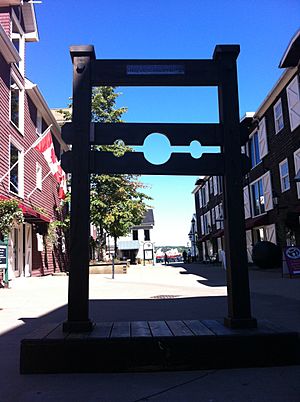
The Historic Properties area has ten of the oldest buildings in Halifax. Seven of these buildings are so important that they have been named National Historic Sites! Here are some of the main buildings you can find at Privateer's Wharf:
- Pontac House (named after the famous Great Pontack restaurant)
- Privateer Warehouse (built around 1790)
- The Red Store (built in 1812)
- King’s Warehouse (built in 1831, now called The Carpenter Shop)
- Wooden Storehouse/Loft
Collins Bank: A Building with History
The building known as Collins Bank, or Simon’s Warehouse, was originally built by Enos Collins in 1832 for his company, the Halifax Banking Company. Over time, this bank grew and eventually became part of the CIBC, a very large bank in Canada today. This building is quite old and has a unique look, with its strong stone walls and large openings that were once used for loading goods.
Pickford and Black Building: Shipping Stories
This building was also built by Enos Collins in 1830. Later, in 1876, it was bought by a shipping company called Pickford and Black. This company was started by two partners, Robert Pickford and William Anderson Black. They were very important in the shipping world of Nova Scotia.
Pickford & Black started by selling supplies to ships and groceries. Soon, they expanded into owning their own steamships. They even started a shipping service that connected Halifax with places like Cuba and Bermuda! They also helped other European shipping lines and acted as agents for big insurance companies like Lloyd's of London. The company continued to grow and change over many years, playing a key role in Halifax's port activities.


